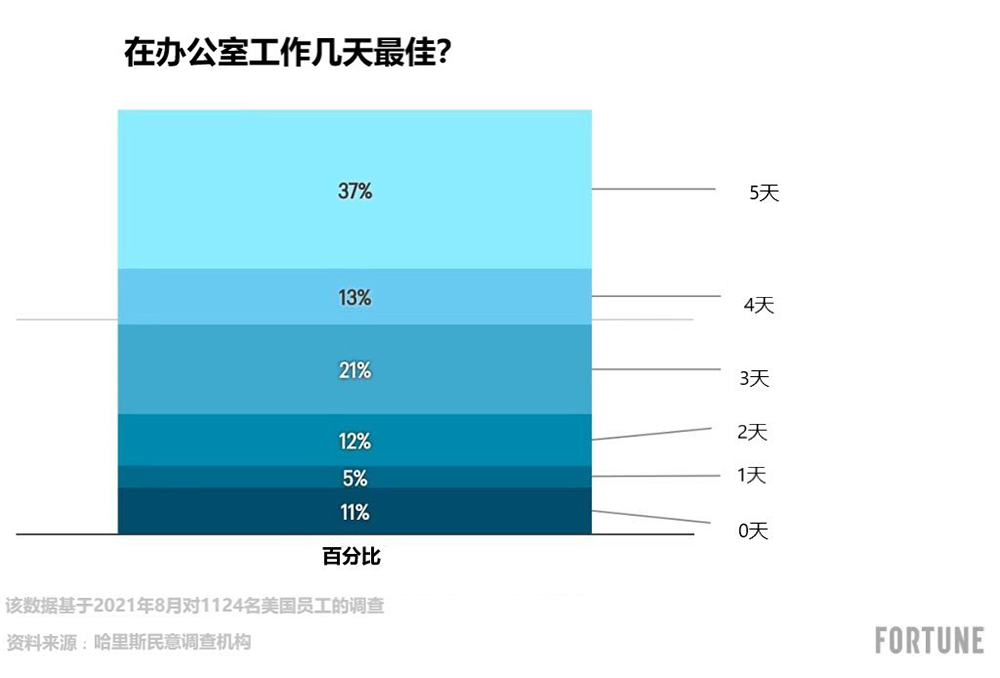美国人正在为今年秋季的混合办公周做准备,许多公司计划让员工可以选择在办公室工作或者远程工作。
但混合办公周能够选择在办公室工作一天到四天,这取决于公司的协议和各个部门经理。那么员工们认为的最佳办公状态是什么呢?哈里斯民意调查机构(Harris Poll)在2021年8月对1100多名美国员工进行的一项新调查显示,每周在办公室工作三天是最佳的办公模式。

不过,尽管大多数员工希望办公有一定的灵活性,但也有很大一部分人希望恢复每周五天工作制。超过三分之一(约37%)的受访者希望回到全职工作岗位。与女性相比,男性更想回办公室上班。男性想在办公室办公的时间为平均每周3.5天,而女性为3.1天。57岁以上的年长员工表示,他们希望平均每周有2.7天在办公室度过,而年轻员工更愿意有3.4天在办公室度过。
调查发现,从基础工作到最高管理层,所有工作级别的最佳工作模式都是一致的,尽管不同行业的情况有所不同。对食品服务、制造业、建筑业和卡车运输业等使用传统工作模式的行业而言,员工认为最佳混合办公周应该是平均每周接近4天在办公室办公。
领先在线工作分配服务平台ZipRecruiter的劳动经济学家朱莉娅•波拉克表示,大约一半的活跃求职者喜欢远程工作。波拉克对《财富》杂志表示,这一趋势在2021年全年都将保持不变。她继而指出,即使在新冠疫情结束后,人们希望远程工作的比例也在45%左右。同时,她补充道,25岁至44岁的员工最想远程工作。
普华永道(PwC)最近的一项调查显示,约18%的公司计划今年秋季实行混合工作制。另有18%的员工计划同时采用线下办公和混合办公模式,19%的员工计划要求今年秋季员工完全线下工作。
普华永道的客户管理经理尼尔•达尔在最近称:“企业有极大的可能在此时改变工作模式。”达尔说,通过改变工作模式,公司可以帮助推动经济效益增长,更好地为未来不确定性做好准备,并打造一个顶级人才渴望加入的工作环境。这可能是一个巨大的优势,因为65%的员工目前正在寻找新工作。(财富中文网)
编译:於欣
美国人正在为今年秋季的混合办公周做准备,许多公司计划让员工可以选择在办公室工作或者远程工作。
但混合办公周能够选择在办公室工作一天到四天,这取决于公司的协议和各个部门经理。那么员工们认为的最佳办公状态是什么呢?哈里斯民意调查机构(Harris Poll)在2021年8月对1100多名美国员工进行的一项新调查显示,每周在办公室工作三天是最佳的办公模式。
不过,尽管大多数员工希望办公有一定的灵活性,但也有很大一部分人希望恢复每周五天工作制。超过三分之一(约37%)的受访者希望回到全职工作岗位。与女性相比,男性更想回办公室上班。男性想在办公室办公的时间为平均每周3.5天,而女性为3.1天。57岁以上的年长员工表示,他们希望平均每周有2.7天在办公室度过,而年轻员工更愿意有3.4天在办公室度过。
调查发现,从基础工作到最高管理层,所有工作级别的最佳工作模式都是一致的,尽管不同行业的情况有所不同。对食品服务、制造业、建筑业和卡车运输业等使用传统工作模式的行业而言,员工认为最佳混合办公周应该是平均每周接近4天在办公室办公。
领先在线工作分配服务平台ZipRecruiter的劳动经济学家朱莉娅•波拉克表示,大约一半的活跃求职者喜欢远程工作。波拉克对《财富》杂志表示,这一趋势在2021年全年都将保持不变。她继而指出,即使在新冠疫情结束后,人们希望远程工作的比例也在45%左右。同时,她补充道,25岁至44岁的员工最想远程工作。
普华永道(PwC)最近的一项调查显示,约18%的公司计划今年秋季实行混合工作制。另有18%的员工计划同时采用线下办公和混合办公模式,19%的员工计划要求今年秋季员工完全线下工作。
普华永道的客户管理经理尼尔•达尔在最近称:“企业有极大的可能在此时改变工作模式。”达尔说,通过改变工作模式,公司可以帮助推动经济效益增长,更好地为未来不确定性做好准备,并打造一个顶级人才渴望加入的工作环境。这可能是一个巨大的优势,因为65%的员工目前正在寻找新工作。(财富中文网)
编译:於欣
Americans are gearing up for a hybrid workweek this fall, with many companies planning to give employees the option of working some days in person and some remotely.
But a hybrid workweek can range from one day in the office to four, depending on the company’s protocols and individual managers. So what’s the sweet spot among employees? Three days a week in the office, according to a new survey by the Harris Poll of over 1,100 U.S. workers fielded in August 2021.
But while the majority of workers want some flexibility, there is a significant portion who want to return to a five-day workweek. Just over a third of respondents, 37%, want to return to the office full-time. And men are slightly more likely to want to return in person than women; men wanted to be in the office an average of 3.5 days a week, compared with 3.1 days among women. Older workers over the age of 57 reported they wanted to spend an average of 2.7 days in the office a week, while younger workers felt more comfortable with 3.4 days in person.
That optimal workweek is fairly consistent across all job levels, from entry level to C-suite, although it does vary a bit across different industries, the survey finds. Workers in industries that are more traditionally in person, such as food services, manufacturing, construction, and trucking, typically reported an optimal hybrid work situation of closer to four days in the office, on average.
About half of active job seekers prefer to work remotely, said Julia Pollak, a labor economist at ZipRecruiter, a leading online employment marketplace. That’s remained consistent throughout 2021, Pollak told Fortune. And the share looking to work remotely even after the pandemic ends is also around 45%, she said, adding that the desire to work remotely is highest among workers ages 25 to 44.
About 18% of companies plan to use a hybrid workweek this fall, according to a recent survey from PwC. Another 18% plan to use a mix of in-person and hybrid options, and 19% plan to require that employees work fully in person this fall.
“Companies have a tremendous opportunity here to transform work,” Neil Dhar, PwC’s chief clients officer recently said. By redesigning the workweek, companies can help drive growth, better prepare for uncertainty, and create a workplace that top talent is eager to join, said Dhar. And that can be a huge advantage as 65% of workers are currently hunting for a new job.






